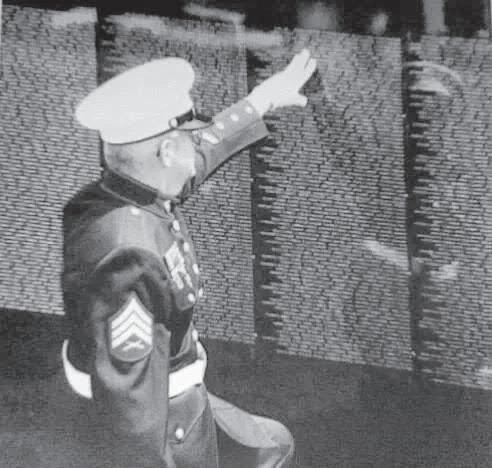





























STORY & PHOTOS BY ANNE GABBIANELLI

When strolling through Bangor’s Mount Hope Cemetery, there is a monument that at first glance looks like something out of a sci-fi movie. No, perhaps it has Gothic overtones, or maybe it’s something that stepped out of Greek literature. But upon further inspection, you learn the bronze and granite monument recognizes the Union Army’s Second Maine Infantry Regiment that fought in several momentous battles in the Civil War.
“Curiosity is usually the first reaction followed by awe and amazement,” said Matthew Bishop, curator of the Bangor Historical Society. He agrees the 15-foot-tall monument is a “head turner” as you drive along the Penobscot River passing Mount Hope Cemetery.
The non-traditional monument, designed by O.V. “Verne” Shaffer of Wisconsin, was dedicated in the early 1960s. It features a bronze sculpture of a faceless angel carrying a wounded soldier. It bears the inscription: “Not painlessly doth God recast and mold anew the nation.” The line is from John Greenleaf Whittier’s anti-slavery poem.

Shaffer, who also had ties to Castine, was quoted in the Bangor Daily News at the time, saying, “I tried in this sculpture not to design just another heroic war memorial, but at the same time wanted to show that heroism existed but not without pain. The face and the figure show pain
and yet the wings express glory. I hope I have succeeded.”
The Second Maine Regiment of Volunteers, also known as the Bangor Regiment, comprised over 1,000 soldiers who marched out of the state in May 1861. As documented in the book “Maine in the War for the Union,” this regiment engaged in “11 bloody and hard-fought battles” including the First Battle of Bull Run, where it was the last regiment to leave the field, and Fredericksburg, where it took its greatest number of casualties.

“Bangor made quite a large contribution to the war just being a central point with train access and mustering grounds,” said Bangor historian Richard Shaw.
He added Bangor also had connections in the political world. “Of course we had Hannibal Hamlin who was an attention getter.” Hamlin,








Abraham Lincoln’s first vice president, is also buried in Mount Hope Cemetery.
Mount Hope Cemetery is home to many prominent people including the man who donated the funds for the Second Regiment monument and much more throughout the Queen City. Bangor native Colonel Luther H. Peirce served with the Second Regiment. He built his wealth through real estate in Chicago, which he bequeathed to the City of Bangor in a trust. The funds were subsequently used for various projects.
The Second Regiment of Maine monument is actually the newest of the three Civil War monuments in the cemetery.
“It’s my understanding the Soldier’s Memorial was erected before the Civil War ever ended, and the citizens of Bangor raised the funds for that memorial,” said Stephen Burrell, Mount Hope Cemetery superintendent. That granite obelisk shaped monument bears the date 1864.






















A unique bronze and granite monument recognizes the Union Army’s Second Maine Infantry Regiment at Mount Hope Cemetery in Bangor.

The Grand Army of the Republic (GAR) fort at Mount Hope Cemetery is dedicated to

Then in 1907, the Grand Army of the Republic (GAR) fort was dedicated to those who served in the Civil War. Funds were raised by patriotic donors and it was rebuilt in 1985 with funds from Peirce’s trust. The masonry tower is half circled with soldiers’ markers and houses a cannon from the Civil War.
While the GAR monument immediately speaks of war, the Second Regiment memorial can be puzzling at first glance.
“The craftsmanship of seeing the figure carrying a person begs for you to stop and learn more. When you read the list of battles that the Second Maine participated in, you see how they were involved in some of the most intense fighting in the Civil War,” Bishop said.






BY WANDA CURTIS



Transitioning from military life to civilian life can be challenging. Some veterans find they lack the training and/or skills needed to succeed in the outside world after discharge. Taking advantage of benefits available under the GI bill, which may cover college tuition, licensing and certification courses, vocational and entrepreneurship training, or flight school training, can make the transition easier.
Veteran Dan Rice is a prime example of someone who used his GI benefits to not only train for a new career but also continue serving others. He spent six years in the Air Force and completed two tours in Iraq in support of Operation Iraqi Freedom at Camp Bucca, Iraq and Baghdad, Iraq, During that time, Rice investigated different educational programs which might be paid for by his GI benefits.
According to Rice, an AMVETS representative explained how to access his benefits after he was discharged. He utilized his benefits under the GI bill and benefits from Vocational Rehabilitation to earn an undergraduate nursing degree and then decided to specialize in anesthesia. He received his Doctorate of Nurse Anesthesia through the United States Army Graduate Program, which he said was fully funded by the Department of Veterans Affairs. He then worked several years at the Togus VA Medical Center in Augusta.
“Upon returning from my second tour in Iraq, I got out of the military,” Rice said. “I had planned to attend physician’s assistant school, but when my application was approved and sent to the GI bill processing center, they denied me funding because my bachelor’s in criminal justice didn’t meet their standard for possessing an undergraduate degree in a related field. So, I decided to get my bachelor’s in nursing (which they would provide funding for) as a stepping stone in that direction…Taking on that challenge and succeeding, laid the foundation for future investments in myself.”
Later, Rice decided to start his own business. He enrolled in the Entrepreneur Boot Camp for Veterans (EBV) at the University of Connecticut School of Business where he received experiential training in entrepreneurship and small business management.
After completing that training, Rice started two businesses which serve Maine, New Hampshire, and Vermont. The first was New England Vascular Access, which provides ultrasound-guided central and peripheral vascular access to small rural hospitals and office settings. The second business was Collaborative Anesthesia Partners, which provides anesthesia coverage for small rural hospitals in Maine. They have also managed entire anesthesia departments. He said that small, rural medical facilities often have a difficult time finding after-hours anesthesia coverage.
More recently, Rice said they formed a first-of-its-kind anesthesia franchise called Collaborative Anesthesia Franchise. He said the goal is “to educate, train, and mentor anesthesia providers to start and operate their own practice in any type of practice setting.”
Rice encourages other veterans to take advantage of their military benefits. He said it’s an opportunity to not only better yourself, but also improve your community. He advises veterans who are interested in accessing their benefits to contact the New England Veterans Chamber of Commerce or AMVETS for assistance in navigating the system.
“GI bill benefits, the Vocational Rehabilitation and Education program, veteran specific scholarships, and programs exist as a benefit for their service,” Rice said. “Veterans should be encouraged to utilize these resources not only for themselves, but as a tool to continue improving our communities. There’s always a program available to help, you just have to find the one that fits you. Most importantly, you must do your research on these programs to determine eligibility because you will meet resistance getting help at times and if you know the rules and remain persistent, you will get them.”


BY CASEY BERNARD

Artwork created by more than 40 Maine veterans is currently on display as part of the annual Maine Veterans Art Exhibit hosted by the Maine Arts Commission. Artworks ranging from photography, painting, sculpture, and crafts will be on display at the State Capitol in Augusta, as well as the Burton M. Cross Office Building and the Maine Arts Commission offices, from Oct. 8 through Feb. 28, 2025.
The program is part of a larger effort by the Maine Arts Commission to support Maine Veterans and encourage their participation in the arts. The artwork in the show is as varied as the veterans who participate and does not necessarily incorporate military subject matter, although some do. The call for submissions went out in September and veterans could
submit up to two pieces of work.
“We know that art is healing and can be medicine for veterans,” said Khristina Kurasz, program director at the Maine Arts Commission. “Many veterans will say that art saved their lives.”
CONTINUED ON PAGE 8





















































































































































































































































































































































































































































































































































CONTINUED FROM PAGE 5
The featured artists will be celebrated at a ceremony on Nov. 13 from 2 to 4 p.m. at Togus Theater in Chelsea. The event, a collaboration between the Maine Arts Commission, the Maine Bureau of Veterans’ Service, Togus VA, and the Quilts of Valor Foundation, will include live music and poetry as well as a panel discussion featuring veteran artists.
At the ceremony approximately 11 local veterans will be awarded with a custommade quilt from Quilts of Valor, a nationwide non-profit organization that awards quilts to veterans who have been touched by war. Local volunteer Sharon Ann Paradis works with quilters across Maine to volunteer their skills to sew quilts designed with the individual veteran in mind. The volunteers receive a profile of each veteran and thoughtfully choose a quilt design that is a unique expression of gratitude for that particular veteran.
“A quilt is a piece of art and to be able to wrap veterans in a quilt is an act of love,” Kurasz said.
Although half of the artists exhibiting this year are new to the exhibit, the Maine Arts Commission recognizes the opportunity to grow the program and offer more opportunities to Maine’s veteran artists. This year, the commission created a dedicated page on its website with resources for veterans, including links to artist residency programs, fellowships, and workshops.
Kurasz is married to a disabled veteran and artist, and understands first-hand the importance of art to the life of veterans. This year, in addition to managing the local veterans art exhibit, she is working with organizations in the Maine art community to encourage them to apply for the Creative Forces Grant, a program through the National Endowment for the Arts. The Creative Forces Grant awards grants ranging from $10,000 to $50,000 for arts-based community engagement projects focused on military-connected






of















Resources for veteran artists can be found at the Maine Arts Commission website at mainearts.maine.gov/Pages/Services/Veteran-Artist-Resources.






communities. The grants have yet to be granted to any Maine nonprofits and Kurasz sees the opportunity for non-clinical art programs and residencies in Maine to take advantage of these grants to further support Maine veterans.














BY CASEY BERNARD
The Marino Project was founded in 2020 by Joe and Jodi Brasslett, owners of Home Roofing Solutions, as a way to give back to the Maine veteran community. Although not veterans themselves, they felt driven to recognize the enormous impact veterans have on the lives of those who they protect through their military service.
The following are highlights from an interview with Jodi.
What is the mission of The Marino Project?
The Marino Project’s mission is to have a direct impact on the lives of Maine military veterans in recognition of the impact they have on our lives.
How did the Marino Project start?
It was Joe’s goal in life to somehow give back to the community and it was our roofing company that has given us the platform to help veterans. As civilians, we feel an incredible debt to veterans who serve to protect us.
The project is named after David Marino, a childhood friend of Joe’s who enlisted in the Marines immediately out of high school. David came from a long line of veterans and served honorably for years, including four tours in Iraq. During his service he was injured and now battles PTSD and a traumatic brain injury. David was once the life of the party and chose to serve at such a young age. To see how his injuries have altered his life so dramatically we wanted to do whatever we could to honor his service and help other veterans with similar challenges.


How does the Marino Project work to achieve its mission?
Each year we host a luncheon for former clients who are veterans. Each veteran who attends is entered into a drawing to receive a $10,000 prize. That money can be used for anything — a vacation, house repair, or just money in the bank.

Last year, as a family, we were discussing other ways we can support the mission. Along with the roofing company, we have a breeding pair of Bernese Mountain Dogs. We decided we would donate one of the puppies, have it trained as a service dog, and donate the pup to a veteran in need. Devin Corson of Maine Refined K9 agreed to spend a year training the dog and at the end of June we placed Magnolia Grace (“Mags”) with a family in Orrington.
The veteran who received Mags suffers from severe anxiety and PTSD and was having trouble being in public spaces and around other people. Within a week of Mags joining the family he was beginning to take small trips to the store and Mags was there to comfort him when he had night terrors. We recently heard he was able to go out even more, like go to the pumpkin patch with his family.
This summer we wanted to raise additional money to support these projects, so we created a car show event with the help of some of our employees who are veterans and car lovers. We rented out the Cross Insurance Center and brought together vintage car owners to create Maine’s largest car show. The event raised more than $30,000 and will allow us to do even more for the veterans.
What advice would you give someone else who wanted to start a nonprofit to support veterans?
We are still a young organization and learning ourselves, but my advice would be to reach out and talk to us! Nonprofits are not in competition. We can all look for ways to collaborate and find ways where we can help. We don’t want to duplicate services, but we also want to help fill in where something is missing.










At the University of Maine at Augusta (UMA), veterans and active duty military personnel will find a wide range of courses, degrees, and services available to them at campuses in Augusta and Bangor, at eight statewide UMA Centers, and online.
Since the University’s founding in 1965 when a sign that read “Welcome Veterans” encouraged Vietnam-era Veterans to enroll, UMA has continued a tradition of supporting military-experienced students. Currently, UMA has over 200 students that are using federal education military and veteran benefits. UMA’s commitment to educating and providing opportunities to veterans, service members, and their families has earned it the following designations: Military Friendly School by G.I. Jobs Magazine; and Best Online Bachelor’s Degrees for Veterans by U.S. News & World Report.
Popular programs for veterans include Aviation, Applied Science, Business Administration, Computer Information Systems, and Cybersecurity. Earlier this year, UMA’s Private Pilot Training program was approved for Veteran benefits as appropriate. This means that eligible veterans can complete their flight courses from Private Pilot through Certified Flight Instructor with UMA. Most programs are available completely online, an area of expertise for which UMA is also recognized.
While delivering college courses online may be new for most institutions throughout the U.S., UMA has been a leader in distance and online education for more than 30 years. Online classes at UMA are facilitated with state-of-the-art videoconferencing software and a Learning Management System such as Brightspace. Many faculty



members allow students who are not be able to attend at the scheduled time to participate by viewing lectures recorded from class and collaborate with classmates to complete and share work.
UMA’s previous 30 years have demonstrated the vital role that technology can play in delivering education outside a traditional classroom, and thereby making education accessible to those who seek to obtain their degree, while maintaining work and family commitments. As technology improves, so does the level of engagement between professors and students, as well as the ease of access.
When not completing courses online, the Veterans Academic Center (VAC) on the Augusta Campus, and a Veterans’ Lounge on the Bangor Campus, provide dedicated space for UMA’s veteran student population. These areas provide a safe environment and place for fellow veterans to seek and lend support to each other and interact with the UMA Office of Military and Veterans’ Services staff.
Amy Line is a UMA alum, adjunct faculty member, a Navy veteran, and Director of Military & Veteran Services at UMA. Line helps students navigate veteran benefits and resources, and was instrumental in securing the private grant funding allowing for the creation of the VAC and its opening in late 2017.
UMA will continue to pursue cutting-edge technologies and seek opportunities to provide high quality education and student support to veterans and others in fulfilling its mission of making higher education accessible to those in Maine and beyond. Learn more





















n the early months of 1991, a group of local veterans took the lead as thousands of community members descended on Bangor International Airport to show gratitude to our nation’s troops. Within those crowds were high school bands and sports teams, scout groups, and families — all here to provide an emotional welcome home to those returning from Operation Desert Storm and to support those deploying to areas of conflict.
At times, there were so many greeters in attendance when flights transited through that cars lined the airport’s access road and the terminal exceeded its capacity. An informal “troop greeter” network had been formed. Military personnel who traveled through BGR told friends and relatives about the warm reception they received here, putting Bangor on the map as national and international news crews converged on the Queen City.
The Gulf War-related flights became memories, but the core group of well-wishers grew into what is now an official non-profit organization known as The Maine Troop Greeters. These dedicated patriots, many of whom are retired military personnel themselves, took the ad hoc nature of these gatherings and turned it into an organized presence in the airport. The 21st century wars in the Middle East would keep troop flights coming and tens of thousands of troops were greeted from 1991 to 2003 before records were maintained. Since 2003, over 1.6 million troops have been met by this community of grateful Americans.
Today, the Maine Troop Greeters is composed of an all-volunteer group who receive notice of flights via a secure notification process. A typical flight consists of 200-250 service members. For those returning from deployment, their first step on U.S. soil is a significant and emotional moment, and for those leaving on a mission, the positive
perspective of being greeted resonates so well that many ask if the Troop Greeters will also be at BGR when their deployments come to an end.
Returning troops are often physically and mentally in a different time zone (by many hours) and exhausted after traveling for days to get home. Their exhaustion turns to smiles and excitement when they hear applause as they walk into the terminal. To be met by 20-30 Troop Greeters ready with handshakes, smiles and a thank you, significantly increases the joy of returning home. The Maine Troop Greeters have collected thousands of letters from troops and their parents expressing how much it meant to be greeted during their stop at BGR.
Thousands of personal items from transiting troops who wanted to return the thanks for warm reception they received have become a massive collection of memorabilia that quickly overwhelmed a storage location. A highly successful fundraising drive created a “world class” museum at Bangor International Airport where those items are safely displayed. The museum has over 6,200 troop-donated Challenge Coins, making it the largest collection in the world. The museum is located adjacent to the airport coffee shop and is open for a few hours each weekday.
The Maine Troop Greeters welcomes new members and greatly appreciates donations, which are used to purchase snacks and toiletry items for soldiers, as well as help with museum operations. If you are at the airport when a troop flight arrives, please join us in welcoming and thanking the transiting troops. Greeting these young men and women who serve our country is a memorable experience and unique to Bangor, Maine.
